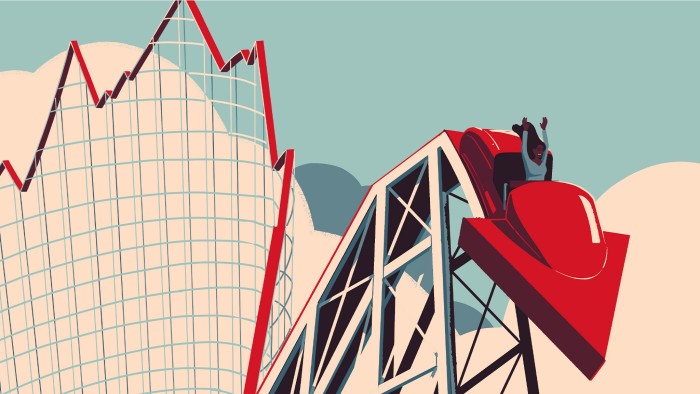Unlock the Editor’s Digest for free
Roula Khalaf, Editor of the FT, selects her favourite stories in this weekly newsletter.
Is market volatility the new normal? Your answer to this question will inevitably depend on how long you think a phenomenon has to persist before it can genuinely be accepted as part of the status quo.
All things considered, I would suggest market uncertainty can now be regarded as par for the course. I say this not just because it has been going on for months but because there seems precious little reason to suppose it will end anytime soon.
This brings us to a second question — one that has been posed repeatedly of late: should investors be worried? The standard response, of course, is that they ought to remain calm.
I have no problem with this argument, which is perfectly sensible. Markets invariably go up and down — sometimes sharply — but the peaks are highly likely to outweigh the troughs over time, so investors with a long-term outlook have no need to panic.
However, what I do have a problem with is fund managers who use this logic as an excuse to sit on their hands and do virtually nothing in the face of fluctuating share prices.
My own reply to the question of whether investors should be worried by volatility is essentially this: “No, they should be excited.” Crucially, I would add that fund managers should be especially thrilled.
Why? Because volatility creates opportunity. Yes, it’s vital to stay composed and keep a sense of perspective — but it’s foolish to ignore the fact that the circumstances in which investors now consistently find themselves are clearly geared towards generating alpha — the market- beating returns.
It’s first useful to understand why volatility occurs. Contrary to popular belief, it’s not merely a consequence of the world apparently falling to pieces.
Broadly speaking, volatility is a corollary of unforeseen events. Everyone appreciates these can include wars, geopolitical tensions, shock policy decisions, global pandemics and the like.
Far less recognised, though, is the role of unpleasant surprises emanating from the ostensibly dull sphere of investment analysis. This so-called “sell-side” part of our industry has become increasingly influential in recent years.
Investment analysts have the task of scrutinising vast amounts of information in order to provide guidance on the attractions or otherwise of specific assets. Of late, largely thanks to the rise of high-frequency trading, most of their outputs have been markedly short term in nature.
Market participants aren’t greatly moved if a short-term analysis proves unduly negative, as the predicted underperformance tends to be “priced in”. In other words, the market as a whole simply readies itself for disappointment.
But the picture can be very different if a short-term analysis proves unduly positive. This is where the dangerous phenomenon of recency bias enters the fray. Market participants might infer that unexpected underperformance signifies permanent underperformance.
This mistaken form of extrapolation is becoming an ever more common source of volatility. It doesn’t mean we should all behave like hedge funds and adopt investment horizons measured in weeks, days or less — but it does remind us that market inefficiencies are there to be exploited.
In my opinion, investors should be wary of fund managers who treat volatility as a justification for inactivity.
This may appear like calmness under pressure. But in reality such an attitude is at best tantamount to passive investing — the stuff of “closet trackers”.
At worst, it’s cowardice. The knee-jerk reaction to volatility shouldn’t be to head for the hills. Market turbulence should encourage managers to get out there and fight for the prizes on offer.
My team specialises in global equities, focusing on smaller companies. We take the view that there’s always a bull market somewhere in the small-cap arena, since fluctuating share prices lend themselves to a kind of zero-sum game in which some companies prosper and others lose out.
How does an investor identify the likely winners? Importantly, it’s best not to rely on the aforementioned sell-side, which can be a hindrance to the process of quantitative and qualitative analysis.
Instead, it’s best first to assess sectors and regions to establish which of them merit closer attention. For example, not least in the face of volatility, where are there signs of positive effects on growth rates or demand?
It’s then about gradually zeroing in on preferred targets. Look for quality, liquidity and, ideally, the potential for unrecognised growth rather than expected growth. For us, as fund managers, this means engaging directly with individual companies to develop a real sense of their strengths and weaknesses — their policies, practices and positioning, their capacity to keep innovating and expanding.
Having gathered further data and insights, models can then be built to try to project future earnings. If projections turn out to be notably higher than the consensus, as is often the case, then that suggests a particularly exciting investment.
Ultimately, a fund manager’s goal shouldn’t be to hide from volatility. Instead, the objective should be to embrace and benefit from it. As the challenge of dealing with volatile markets continues, investors need to be aware that there’s a big difference between prudent calm and wilful inertia.
Tobias Bucks is co-manager of the Marlborough Global SmallCap Fund
